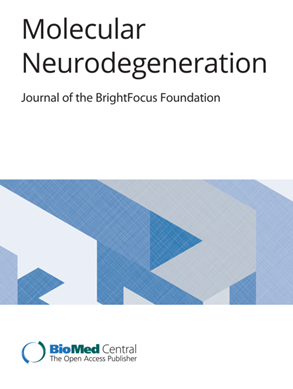18F-MK-6240 tau PET在慢性创伤性脑病风险患者中的作用
IF 17.5
1区 医学
Q1 NEUROSCIENCES
引用次数: 0
摘要
慢性创伤性脑病(CTE)的分子生物标志物缺乏。我们评估了18F-MK-6240 tau PET作为CTE的生物标志物。进行了两项研究:(1)3H-MK-6240放射自显影和死后CTE组织的体外脑匀浆结合研究;(2)前美式橄榄球运动员体内18F-MK-6240 tau PET研究。使用3H-MK-6240对6例尸检的III期CTE(与阿尔茨海默病相比)患者的冷冻颞叶和额叶皮质组织进行放射自显影和体外结合研究。30名有认知问题的前美国国家橄榄球联盟(NFL)男性球员(平均年龄58.9岁,SD = 7.8)完成了tau (18F-MK-6240)和Aβ (18F-Florbetapir) PET。对照组包括39名Aβ-PET阴性,认知正常的男性(平均年龄= 65.7,SD = 6.3)。18F-MK-6240 SUVr图像以注射后70-90分钟的小脑下灰质为参考。我们使用体素和兴趣区域方法比较了玩家和控制者之间的SUVr。测试18F-MK-6240 SUVr与认知评分的相关性。所有6例CTE III期病例均有Braak NFT III期,但无神经性斑块。其中2例为Aβ的Thal 1期;其中一个在颞上皮层显示3H-MK-6240层状自显影结合,而在背外侧额叶皮层则较少,对应于在邻近组织切片中使用AT8抗体(pSer202/pThr205 tau)检测到的tau免疫反应性病变。其他CTE病例有低频率的皮质tau免疫反应性沉积,无明确的放射自显影结合。3H-MK-6240与CTE脑匀浆的体外结合研究显示,在放射自显影信号的病例中,3H-MK-6240具有较高的结合亲和力(KD = 2.0±0.9 nM, Bmax = 97±24 nM, n = 3)。所有NFL球员Aβ-PET均为阴性。参与者的18F-MK-6240摄取有不同程度的低至中等强度:16人没有皮质信号,7人有内侧颞叶(MTL)摄取,2人有额叶摄取,4人有颞叶和额叶摄取。NFL运动员的内嗅皮层(d = 0.86, p = 0.001)和海马旁回(d = 0.39, p = 0.08)的SUVr较高。体素回归显示,NFL球员在两个双侧前MTL群中的摄取增加(p < 0.05 FWE)。较高的海马旁区和额颞叶区suv分别与较差的记忆(r = -0.38, r = -0.40)和语义流畅性(r = -0.38, r = -0.48)相关。我们提出了3H-MK-6240在体外与死后CTE组织匀浆结合的证据,以及18F-MK-6240在MTL中与一部分参与者体内PET结合的证据。为了进一步阐明18F-MK-6240在CTE中检测tau病理的潜力,需要对更大样本和pet与尸检的相关性进行进一步的研究。本文章由计算机程序翻译,如有差异,请以英文原文为准。
18F-MK-6240 tau PET in patients at-risk for chronic traumatic encephalopathy
Molecular biomarkers of chronic traumatic encephalopathy (CTE) are lacking. We evaluated 18F-MK-6240 tau PET as a biomarker for CTE. Two studies were done: (1) 3H-MK-6240 autoradiography and an in-vitro brain homogenate binding studies on postmortem CTE tissue, (2) an in-vivo 18F-MK-6240 tau PET study in former American football players. Autoradiography and in-vitro binding studies were done using 3H-MK-6240 on frozen temporal and frontal cortex tissue from six autopsy cases with stage III CTE compared to Alzheimer’s disease. Thirty male former National Football League (NFL) players with cognitive concerns (mean age = 58.9, SD = 7.8) completed tau (18F-MK-6240) and Aβ (18F-Florbetapir) PET. Controls included 39 Aβ-PET negative, cognitively normal males (mean age = 65.7, SD = 6.3). 18F-MK-6240 SUVr images were created using 70–90 min post-injection data with inferior cerebellar gray matter as the reference. We compared SUVr between players and controls using voxelwise and region-of-interest approaches. Correlations between 18F-MK-6240 SUVr and cognitive scores were tested. All six CTE stage III cases had Braak NFT stage III but no neuritic plaques. Two had Thal Phase 1 for Aβ; one showed a laminar pattern of 3H-MK-6240 autoradiography binding in the superior temporal cortex and less so in the dorsolateral frontal cortex, corresponding to tau-immunoreactive lesions detected using the AT8 antibody (pSer202/pThr205 tau) in adjacent tissue sections. The other CTE cases had low frequencies of cortical tau-immunoreactive deposits and no well-defined autoradiography binding. In-vitro 3H-MK-6240 binding studies to CTE brain homogenates in the case with autoradiography signal indicated high binding affinity (KD = 2.0 ± 0.9 nM, Bmax = 97 ± 24 nM, n = 3). All NFL players had negative Aβ-PET. There was variable, low-to-intermediate intensity 18F-MK-6240 uptake across participants: 16 had no cortical signal, 7 had medial temporal lobe (MTL) uptake, 2 had frontal uptake, and 4 had MTL and frontal uptake. NFL players had higher SUVr in the entorhinal cortex (d = 0.86, p = 0.001), and the parahippocampal gyrus (d = 0.39, p = 0.08). Voxelwise regressions showed increased uptake in NFL players in two bilateral anterior MTL clusters (p < 0.05 FWE). Higher parahippocampal and frontal–temporal SUVrs correlated with worse memory (r = -0.38, r = -0.40) and semantic fluency (r = -0.38, r = -0.48), respectively. We present evidence of 3H-MK-6240 in-vitro binding to post-mortem CTE tissue homogenates and in vivo 18F-MK-6240 PET binding in the MTL among a subset of participants. Additional studies in larger samples and PET-to-autopsy correlations are required to further elucidate the potential of 18F-MK-6240 to detect tau pathology in CTE.
求助全文
通过发布文献求助,成功后即可免费获取论文全文。
去求助
来源期刊

Molecular Neurodegeneration
医学-神经科学
CiteScore
23.00
自引率
4.60%
发文量
78
审稿时长
6-12 weeks
期刊介绍:
Molecular Neurodegeneration, an open-access, peer-reviewed journal, comprehensively covers neurodegeneration research at the molecular and cellular levels.
Neurodegenerative diseases, such as Alzheimer's, Parkinson's, Huntington's, and prion diseases, fall under its purview. These disorders, often linked to advanced aging and characterized by varying degrees of dementia, pose a significant public health concern with the growing aging population. Recent strides in understanding the molecular and cellular mechanisms of these neurodegenerative disorders offer valuable insights into their pathogenesis.
 求助内容:
求助内容: 应助结果提醒方式:
应助结果提醒方式:


